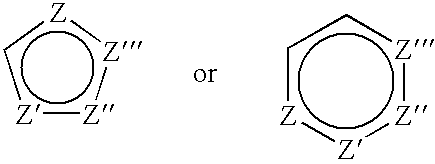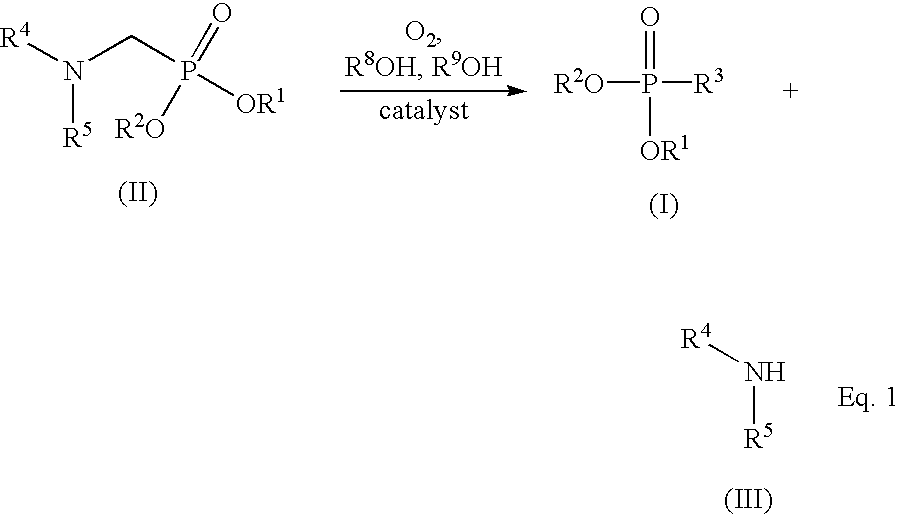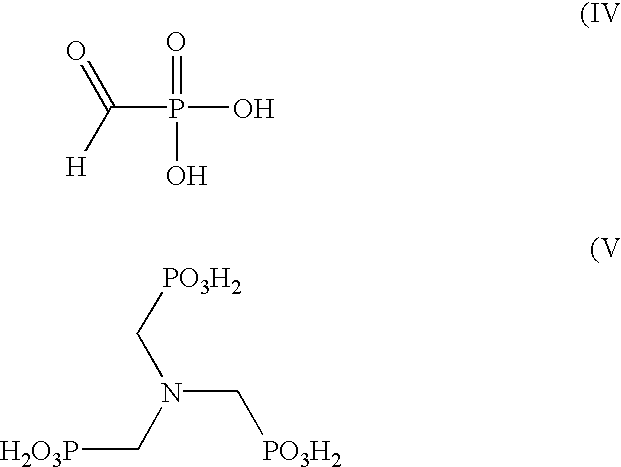Method for preparing formylphosphonic acid
a technology of mylphosphonic acid and phosphonic acid, which is applied in the field of preparation of mylphosphonic acid, can solve the problems of poor or unreported yield of formylphosphonic acid, higher maintenance needs and costs, and environmental and equipment corrosion problems
- Summary
- Abstract
- Description
- Claims
- Application Information
AI Technical Summary
Benefits of technology
Problems solved by technology
Method used
Image
Examples
example 2
[0069] Temperature and Catalyst Comparison.
[0070] The following reactions were carried out as described in Example 1, except as indicated in Table 3. The results summarized in Table 3 compare the effect of temperature and catalyst choice on conversion and selectivity to FPA. All conversion and selectivity data were obtained by .sup.31P{.sup.1H}HMR on filtered aliquots of the product mixture.
3TABLE 3 Examples of ATMP oxidations with various carbon catalysts and at different temperatures Reaction FPA FPA Temperature time, Conversion selectivity yield, Catalyst .degree. C. minutes % % % HPL 65 146 91 88 80 HPL 85 60 97 73 71 Norit SX 75 300 63 69 43 Plus Norit 75 300 73 70 51 SA-3
example 3
[0071] Oxidation of N-methyliminobis(methylenephosphonic Acid).
[0072] A 300-mL stainless steel autoclave was charged with N-methyliminobis(methylenephosphonic acid) (18.36 g, 83,81 mmol), 164 mL water, and 1.54 g of previously-used HPL carbon catalyst. The oxidation was carried out at 75.degree. C. and pressure of 65 psig with an oxygen flow of 38 sccm into the rapidly stirred autoclave. After 240 minutes, the filtered reaction product was analyzed as described above. Results revealed a 24% conversion of starting material with a selectivity of 69% for FPA. The amine co-product was N-methyliminomethylenephosphonic acid.
example 4
[0073] Oxidation of Isopropyliminobis(methylenephosphonic Acid).
[0074] A reaction was carried out as described in Example 3 using N-isopropyliminobis(methylenephosphonic acid) (15.00 g, 60.70 mmol), 160 mL water, and 1.44 g of previously-used HPL carbon catalyst. After 294 min, the filtered reaction product was analyzed as described in Example 1. Results revealed a 58% conversion of starting material with a selectivity of 76% for FPA. The major amine co-product was N-isopropylimino(methylenephosphonic acid).
PUM
| Property | Measurement | Unit |
|---|---|---|
| temperature | aaaaa | aaaaa |
| temperature | aaaaa | aaaaa |
| temperature | aaaaa | aaaaa |
Abstract
Description
Claims
Application Information
 Login to View More
Login to View More - R&D
- Intellectual Property
- Life Sciences
- Materials
- Tech Scout
- Unparalleled Data Quality
- Higher Quality Content
- 60% Fewer Hallucinations
Browse by: Latest US Patents, China's latest patents, Technical Efficacy Thesaurus, Application Domain, Technology Topic, Popular Technical Reports.
© 2025 PatSnap. All rights reserved.Legal|Privacy policy|Modern Slavery Act Transparency Statement|Sitemap|About US| Contact US: help@patsnap.com



